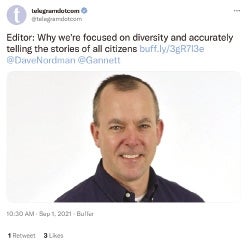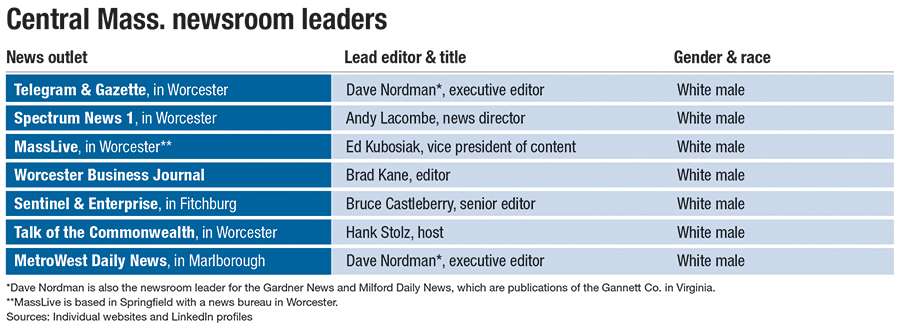
Who tells the news: The Central Mass. media ecosystem lacks diversity
 Photo/Courtesy of Twitter
Dave Nordman, executive editor of Worcester Telegram & Gazette
Photo/Courtesy of Twitter
Dave Nordman, executive editor of Worcester Telegram & Gazette
More Information
News media in Central Massachusetts has a diversity problem.
Although tasked with reporting on a diverse array of communities – U.S. Census Bureau data shows 31% of Worcester residents are nonwhite, with about 26% of residents identifying as nonwhite throughout Worcester County – all editors and editorial leads at organizations which provide daily news coverage in Central Massachusetts are white men. Full disclosure, that includes the Worcester Business Journal.
The homogeneity among news editorship in Central Massachusetts is not unique to the region, but it does bring with it inherent questions about who decides what stories are newsworthy, and who decides how they are told.
“Newsroom management [positions] have historically been held by white males, and that impacts the news product,” said Daniel Hunt, associate professor of communication and director for the Center for Community Media at Worcester State University. “Editors and managers make important editorial decisions that are guided by their backgrounds, and that’s going to effect the audience they serve.”
White newsrooms
Nationally, 19% of news managers are people of color, according to the 2018 American Society of News Editors Newsroom Employment Diversity Survey, the most recent year in which the survey was conducted. However, the ASNE noted that year also had the lowest participation rate in the survey’s 40-year history. The year before, the percentage of people of color who held newsroom manager positions was 13.4%.
The trend toward whiteness in newsroom management appear to have trickle-down consequences for staffing, with the ASNE reporting newsrooms with racially diverse leadership tend to have a more racially diverse staff.
In tandem with this, a 2018 report from the Pew Research Center in Washington D.C., pulling data from the 2012-2016 American Community Survey from the Census, found 77% of newsroom employees around the U.S. are non-Hispanic whites. That data included jobs like reporters, editors, photographers and videographers in newspapers, broadcast journalism and online-only outlets. All newsroom staff at WBJ are white, including this reporter.
The same Pew Research report indicated 61% of newsroom employees are men, with 48% reported as non-Hispanic white men.
The Telegram & Gazette, Worcester’s oldest operating daily newspaper and the paper of record for the region, acknowledged in August 2020 its staff did not reflect the diversity of the communities it covers, and promised to do better, in an op-ed published by Executive Editor Dave Nordman.

“We will recruit people with diverse voices from the community or local colleges to contribute to our opinion and commentary pages,” Nordman wrote at the time. “We must amplify voices that historically have not had an opportunity to reach our readers.”
The op-ed was published as part of a wider initiative from its parent company, Gannett Co. of Virginia, during which editors across its network shared newsroom diversity figures and pledged to do better, including a promise to reach gender, racial, and ethnic staff parity by 2025.
That data, and that promise, was updated on Sept. 1 of this year. Nordman declined to be interviewed for this piece, pointing instead to that update.
Per the update, the T&G’s newsroom is 86.2% white, and newsroom managers are 100% white. That’s 0.3 percentage points lower than a year prior for newsroom staff overall. At the same time, the newsroom decreased from 8.1% Black employees to 0%, and rose from 0% to 10.3% Asian employees, year-to-year. The community the paper covers is 5.8% Black and 4.3% Asian, per the T&G data report.
The paper also saw an increase from 0% to 3.4% Hispanic/Latino employees in its newsroom. The community the T&G covers is 17.1% within that demographic.
At the same time, the paper reported its newsroom is 72.4% male in 2021, up from last year when that figure was 67.6%. News managers were 66.7% male, a decrease from the year prior, when that figure was 83.3%. These figures were accurate as of July 13.

How stories are told
Diversity in the newsroom, given the outward-facing nature of journalism, is about more than staffing. It concerns what stories are told and how they are presented, including who is used for sources. From elected officials to business leaders, community members and more, journalists pull on a wide variety of people’s perspectives to help them do their job.

Nordman, for his part at the T&G, said in his Sept. 1 op-ed the paper has changed the way it reports on crime.
“We produce more enterprise and solution-based stories instead of just feeding traditional racial stereotypes,” Nordman wrote. “We report criminal backgrounds only when clear relevance is established, and we no longer use race in descriptions of suspects.”
Crime stories are a diversity-in-journalism issue because in many newspapers, including in Central Massachusetts and far beyond, they have often provided knee-jerk fodder for coded racist language in both headlines and reporting, as well as a penchant for relying on just one side – usually law enforcement – to tell the story of what happened from arrest to arrest.
There’s been a push away from that kind of reporting, recognizing police reports only tell one piece of a story, as well as the ways the criminal justice system has a disproportionately negative effect on low-income communities and communities of color. For reference, annual crime data reported on by the state of Massachusetts shows that Black or African American individuals comprised 19% of 77,721 arrests made in 2020, while the overall Black and African American population in the state is 9%, according to Census data.

Another news outlet in Central Mass. moving away from old school crime reporting is Spectrum News 1, a regional cable news network based in part in Worcester, and led by News Director Andy Lacombe, who has worked in the Worcester news ecosystem for more than two decades.
“We’re not really chasing fires and crime like our news station would have done years ago ... We’re chasing the issues around those things. We’re trying to tell character-driven stories,” Lacombe said.
That shift, he said, began in 2019.
At the same time, beyond crime and fire stories, Lacombe said his news team regularly discusses how to include many perspectives from different communities as they can with the goal of actively diversifying their coverage.

Hurdles to diversifying staff
The Central Massachusetts news media ecosystem runs the gamut from independently run news radio programs to newspapers run by billion-dollar, out-of-state corporations. This makes finding cohesion in the industry a challenge, and leaves the issue of hiring and promoting a more diverse staff up to individual companies.
One hurdle to diversifying staff has been a lack of industry hiring, said Mark Henderson, who worked at the T&G for 15 years and is now CEO and founder of The016 local social media site, which aggregates local news stories. Henderson pointed to both a spate of layoffs across news media, as well as a tendency for some of the older guard reporters to stick around for decades.
“It’s very hard as an industry to measure up to evolving standards ... in an industry that wasn’t hiring,” Henderson said.
The second hurdle, from Henderson’s perspective, is the news media has so firmly cemented its audience – that audience being white – that from a business perspective, expanding can be a challenge. Newsrooms like those in Central Massachusetts are tasked with retaining their paying audience, while needing to expand their coverage to include communities they may have neglected reporting on in the past.
It’s a two-pronged issue where one problem runs the risk of exacerbating the other.
“If the newsroom looks like the audience, they’re going to write about that audience,” Henderson said.

Professor Hunt, from Worcester State, would like to see more support from community media outlets, which may not always include straightforward traditional journalism, but which provide opportunities for members of the community to platform stories and issues important to them. He pointed to local public access television stations like WCCA TV, or WCUW 91.3 community access radio.
“When we have content creators or reporters that are from communities that they serve, they're going to have a better understanding of the values and the richness of those communities,” Hunt said.









0 Comments